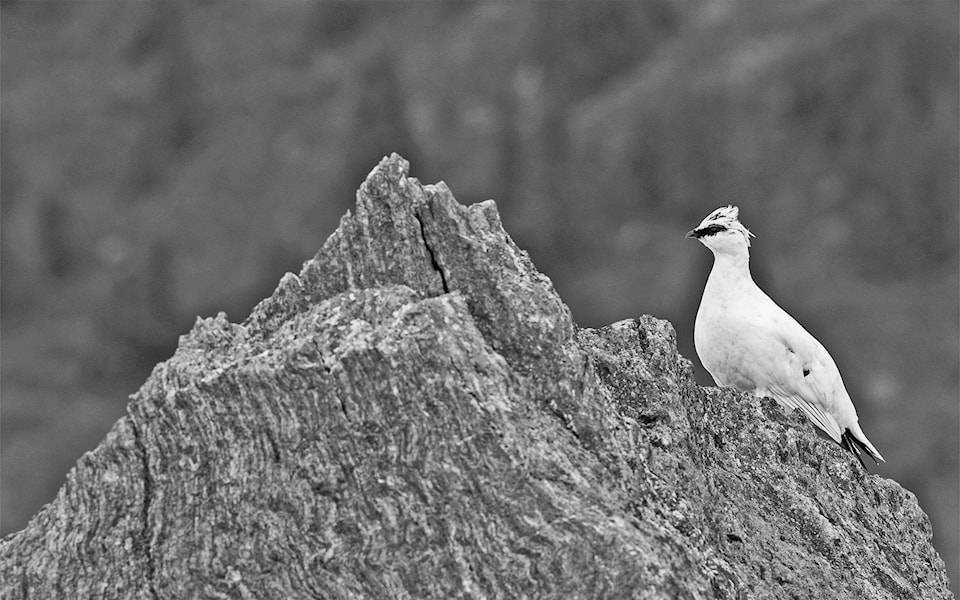Humans aren’t the only Yukon residents getting ready for the long, dark and cold winter ahead.
Among our furry and feathered kin hunkering down for the season is the humble ptarmigan, which, according to longtime Yukon bird biologist and naturalist David Mossop, is incredibly well-adapted to survive winter in the North.
Ptarmigan are actually a kind of grouse, Mossop explained, three species of which are found in the Yukon: the willow ptarmigan, rock ptarmigan and white-tailed ptarmigan.
The willow ptarmigan is the most important of the trio, Mossop said, and is considered a keystone tundra species that serves as a “funnel” between the plant and animal kingdoms — thousands of them feast on vegetation out on the land, converting plants into animal protein that then becomes crucial for the predators that feast on them.
What all ptarmigan have in common this time of year, though, is their unmistakable change in appearance, transitioning from their brown-speckled spring-summer plumage to a pure-white one that blends in seamlessly with the snow.
“Turning white in the winter, it’s an interesting phenomenon because basically what happens is that grouse are one of the birds that molt all of their what we call the conture, which is kind of their clothing, twice a year,” Mossop said. “They don’t molt their flight feathers and their tail feathers, those are the great big feathers … but they molt the rest of their feathers twice, and so when it comes fall, simply, they molt their brown feathers and when their feathers return, they’re white.”
Besides camouflage, turning white also serves another practical and important purpose for the birds — it actually keeps them warmer.
“It turns out that white feathers are produced simply by the bird not putting any pigment into the feather, makes sense… The white feathers are white because the little barbules and things in the shaft of the feather have air in them, so there’s no pigment and they simply leave them empty and they have air in them,” Mossop said. “So air, being an insulator, the white feather is actually a warmer feather. The same-sized feather, white, is warmer than a dark feather, which is fascinating, but it makes all kinds of sense.”
Ptarmigan are also growing their winter footwear around this time.
“Grouse are among the only birds that actually have feathered toes, so they actually grow feathers right on to the ends of their toes … So ptarmigan snowshoes involve those big long feathers they grow on their toes but also huge toenails, they grow big flat toenails that extend out, gosh, it’s almost a third of the toe length and allows them obviously to walk on snow surface,” Mossop said, explaining that the “snowshoes” wear off in the summer.
For Mossop though, what’s even more fascinating than the dramatic change in physical appearance is the shift in how ptarmigan behave.
“Ptarmigan spend their whole summer hating each other. They’re territorial, ‘Hey, get out of my yard,’ and they have calls and all kinds of behaviour that involves keeping other ptarmigan away from them, so they spread out all over the habitat,” he said.
“This time of year, there’s a switch that just switches and they suddenly love everybody and they start forming winter flocks… It’s just an astounding change, these birds that all summer long apparently can’t stand each other, get out of my yard, get away from me, all of a sudden, they have all this behaviour that talks about keeping us together, ‘Stay together buddies, I love you all and I want to be with you,’ blah blah blah. It’s a huge change. It’s as striking as changing white.”
By flocking together, Mossop explained, ptarmigan are safer from medium-sized predators like foxes and gyrfalcons, which he described as “built to eat ptarmigan.”
Besides the physical and behavioural changes, ptarmigan in general are well-adapted for not just surviving, but thriving through longer northern winters: unlike many other birds, they actually roost in the snow, burrowing underneath the surface to build their homes, and have digestive systems and beaks specifically geared towards a winter diet of “browsing,” or eating things like twigs and buds that stick up above the snow’s surface.
They’re so good at winter that, unlike many other critters, they actually gain weight.
“One of the research projects I’ve been involved with years ago was looking at what happens to them in the wintertime. It’s a tough time for crying out loud,” Mossop said. “We’ve always thought that winter birds must be, you know, that must be the time they die, it must be tough. It turns out that ptarmigan gain weight all winter. They’ve got it licked, they’re doing just fine, thank you.”
And for anyone who’s made cracks at a ptarmigan’s expense after seeing a bird acting a little less than savvy — failing to get out of the way of an approaching vehicle, for example — Mossop said to look at the situation from another angle.
“They don’t have to solve problems … Well-adapted things like that, they don’t have to solve problems, they’re so well-adapted at what they do,” he said.
“Owls? Owls, we all think are intelligent, you know, the old wise owl. They’re actually pretty stupid. They don’t have to solve problems. They’re just excellent at what they do and so well-adapted creatures. Scavengers that have to solve problems like ravens and things, we see what we interpret as intelligence in them because, again, they’re solving problems constantly … ‘Intelligence’ is a weird thing. It’s misconstrued all the time in people’s heads.”
Contact Jackie Hong at jackie.hong@yukon-news.com
